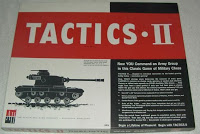As some of my long-time readers may recall, I was a wargamer before I was a role-player. Back then, there were two major wargame companies; Avalon Hill and SPI. I had a ton of both company’s games, as well as some others from smaller publishers, and it’s true to say my love of hex-and-counter wargames didn’t go away once I found Dungeons & Dragons. Indeed, the two hobbies, being so closely related in history and audience, went hand in hand for me and my group of gamers (as well as less wargamey board games from Avalon Hill like Dune, Diplomacy, Kingmaker, etc.).
My first exposure to wargames came when I was 8 years old. One of my friends’ parents had a game tucked under an end table that was unlike anything I’d seen before. I was used to playing Risk, Oil Tycoon, Titanic, Monopoly, and those sorts of games. But this was completely different. I asked to borrow it, and as they had never really played it, they said I could go ahead and keep it.
For weeks I stayed up way later than I should have that summer forcing myself to read through the rules. I was a very young reader thanks to my mother, and although it was tough for me to get some of the concepts at first (the way all contiguous units had to attack if one of them did was especially weird for me), eventually I figured it out and started playing with my best friend at the time. He got as hooked as I did, and the rest is history.
Tactics II is a really good introductory game. It uses a square grid map rather than hexes, and features a war between two imaginary countries; Blue and Red. Unit types are fairly standard and use the then-normal practice of NATO symbols to denote troop types, so infantry had a rectangle with an X in it, armor had a rectangle with an oval, etc. Each unit has two numbers; a combat factor and a movement factor. It used the standard Avalon Hill CRT (Combat Results Table) that helped you calculate the ratios of the combat factors, and which I’d see over and over in different AH games.

Different types of terrain cost different amounts of movement points to enter, and there were roads an bridges that made you move faster. There were also some optional advanced rules for paratroops, tactical nuclear weapons, amphibious landings, etc. It’s also eminently suitable for solitaire play.

We played that game endlessly that summer, and then convinced my mother to take us into New York City to visit a game store called Polk’s Hobbies, which was in the Empire State Building. They had a selection of wargames among many other things (I would amass a very large collection of Atlantic plastic miniatures; Romans, Egyptians, etc.). But the salesman mentioned that there was another store only a block away called the Compleat Strategist. And that was all it took; Invasion America was the first game I ever bought, and World War 3 (both by SPI) was my best friend’s purchase that same day. We went back to the well many times, with Afrika Korps, War of the Ring, Prestags, War in the Ice, After the Holocaust, World War 2, Operation Sealion, and many, many more.
But it was that chance glimpse of Tactics II at my friend’s house that started it all off for me. I still have a great fondness for the game, and break it out every once in a long while to be 8 again.










I recently replayed Tactics II. Actually a bit better than I remembered 😉